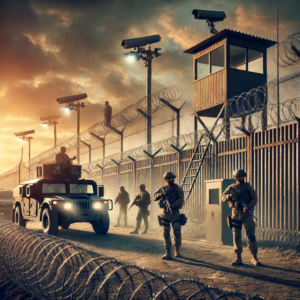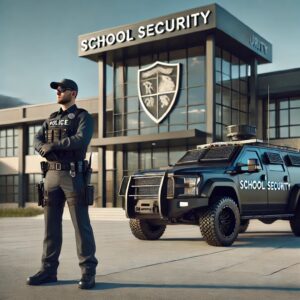
Introduction: Lessons from National Security
In the ever-evolving landscape of school security, we must look beyond traditional safety measures and adopt proven defense strategies used by national security agencies. Recently, Defense Secretary Pete Hegseth introduced the concept of “repel and seal” as a border security strategy—one that focuses on deterring threats before they reach critical areas and reinforcing barriers to prevent breaches.
As school security professionals, we must ask ourselves: How can we apply these same principles to keep our students and staff safe? Just as Border Patrol and the U.S. military use layered defenses, rapid response teams, and advanced surveillance to secure our nation, school security teams must develop comprehensive protection strategies to ensure that threats never reach the classroom.
Understanding the “Repel and Seal” Approach in School Security
1. Repel: Deterrence and Prevention
The first step in securing any location is deterring threats before they materialize. Much like how the U.S. military and border patrol use strong physical barriers, visible security forces, and advanced surveillance, schools must invest in measures that repel bad actors before they even attempt entry.
Key deterrence strategies include:
• Perimeter Security – Installing fencing, locked gates, and access-controlled entry points to limit unauthorized access.
• Surveillance and Monitoring – Utilizing AI-powered cameras, motion sensors, and real-time security monitoring to detect potential threats before they escalate.
• Visible Security Presence – Trained school resource officers (SROs), armed security personnel, and proactive patrols serve as powerful deterrents against intrusions.
• Behavioral Threat Assessment – Identifying and addressing early warning signs of potential threats through behavioral analysis and reporting systems.
A strong deterrence strategy increases the risk for would-be attackers and forces them to rethink their plans before attempting to breach school grounds.
2. Seal: Containment and Access Control
While deterrence plays a crucial role, it is not enough on its own. Schools must also reinforce security layers to ensure that if an individual with bad intentions attempts to enter, they are stopped in their tracks.
Key containment strategies include:
• Single Entry Point Enforcement – Controlling school access by directing all visitors through a secure, monitored entrance.
• Electronic Access Control – Using keycard systems, biometric authentication, and remote lockdown capabilities to manage access.
• Classroom and Hallway Security – Ensuring all classroom doors remain locked, reinforced with shatter-resistant glass and secondary locking mechanisms.
• Emergency Response Protocols – Implementing rapid lockdown systems, panic buttons, and crisis communication networks to seal off potential threats before they escalate.
A properly sealed school security system ensures that even if a potential threat bypasses deterrence measures, they cannot progress further into the building or harm students and staff.

Applying Military-Grade Security to Schools
The U.S. military doesn’t wait for threats to arrive; they anticipate and prepare for worst-case scenarios in advance. Schools must adopt the same mindset by developing a proactive, layered security strategy that integrates technology, personnel, and procedural safeguards to stop threats before they start.
Some critical components of a military-inspired school security framework include:
• Command and Control Centers – Just like military bases have operations centers, schools should have centralized security hubs where personnel monitor live security feeds and coordinate emergency responses.
• Intelligence-Driven Security – Military and border security forces rely on data analytics and intelligence gathering—schools should use predictive security software, anonymous reporting apps, and digital threat assessments to identify risks early.
• Active Defense Training – Law enforcement and military personnel train regularly for active threat scenarios—school security teams must also drill, train, and prepare to respond with speed and precision.
Commitment to the “Not Our Kids” Promise
At the heart of every security initiative is one mission: protecting students and staff. By applying the repel and seal approach to school security, we reinforce our commitment to gold-standard safety and stand by our “Not Our Kids” promise—ensuring that threats are stopped long before they reach the classroom.
The time for reactive security is over. It’s time for a proactive, defense-driven approach that stops threats before they happen.
Final Thoughts: The Future of School Security
As security professionals, we must constantly evolve, adapt, and innovate to stay ahead of threats. By integrating military-grade defense strategies, leveraging cutting-edge technology, and fostering a culture of vigilance, we can ensure that schools remain safe havens for learning, growth, and success.
Key Takeaways:
✅ Repel threats with deterrence strategies – strong perimeters, visible security, surveillance, and intelligence gathering.
✅ Seal off vulnerabilities – access control, lockdown measures, emergency response protocols.
✅ Think like the military – layered defenses, proactive security operations, and rapid response training.
✅ Uphold the “Not Our Kids” promise – no compromises when it comes to student safety.
The battle for school security is not won with hope—it is won with preparedness, vigilance, and decisive action. Let’s ensure that our schools remain fortified, protected, and impenetrable to threats.
#SchoolSecurity #RepelAndSeal #NotOurKids #GoldStandardSecurity #SchoolSafety #PeteHegseth #SecurityConsulting #SafeSchools



